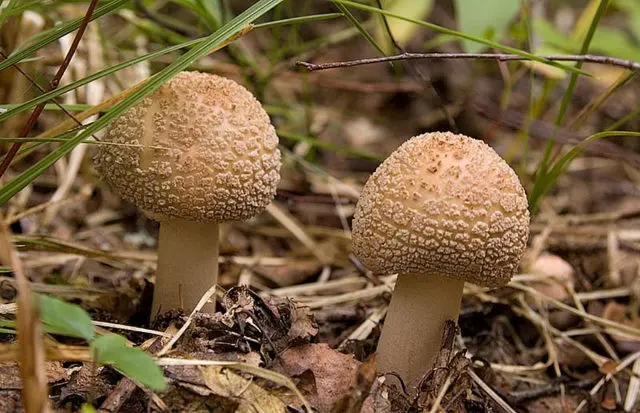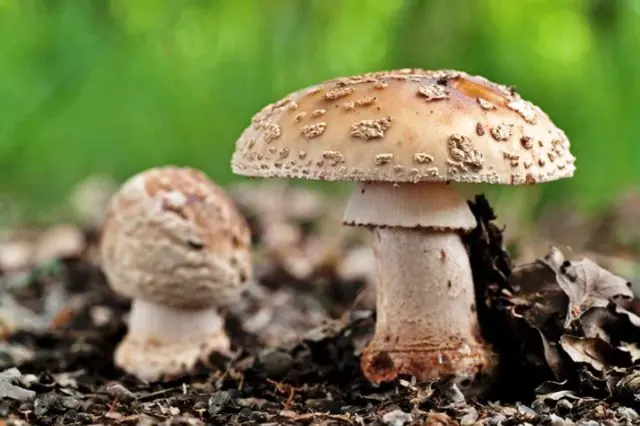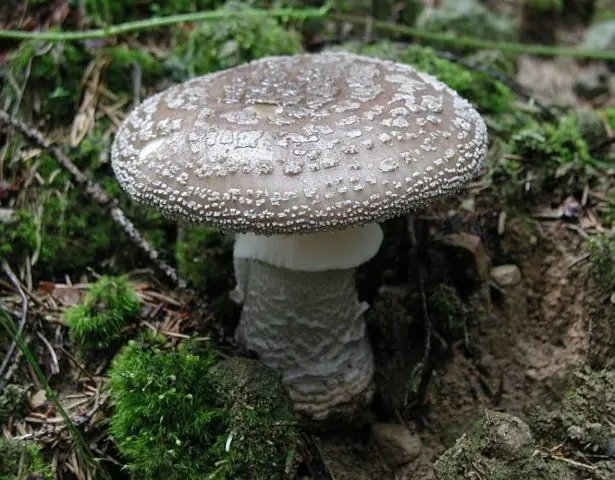Contents
Amanita pearl is a representative of the numerous genus of the same name of the Amanitaceae family. Mushrooms are large, with the remains of a bedspread on the hat.

Only experienced mushroom pickers can distinguish between poisonous and edible species.
Description fly agaric pearl
Representatives of the variety are quite large. In the forest, they are noticeable in a light color.
Cap Description
The width of the cap is up to 10-11 cm. At first it is convex, yellow-brownish or pinkish, then darkens, shades of red-brown appear. Small and large scales remain on the glossy smooth surface. The loose plates are also white, as is the spore powder.

Scales granular, whitish
Description of the leg
Steady stem 2-3 cm in diameter, up to 14 cm high. A thickening with ring-shaped remains of the bedspread is noticeable downwards. The velvety surface is matte, identical to the color of the hat or a tone lighter. From above, a leathery white ring with descending grooves. The white juicy pulp turns red after being cut, it smells pleasant.

The remains of the Volvo are visible, turned into circular folds.
Where and how to grow
Pearl – a widespread fungus with no special preferences for soils, found in mixed, coniferous and deciduous forests from mid or late June to October. More often the species is found under birches, oaks or spruces. In Our Country, the variety is characteristic of the temperate zone.
Is the pearl fly agaric edible or poisonous?
The fruit bodies of the species are considered edible, in many European countries – conditionally edible. Mushroom from the genus Fly agaric should not be consumed raw, but only after heat treatment. Fruit bodies are soaked, peeled off the caps and boiled for 20-30 minutes, the water is drained. Also, mushrooms are not dried, but pickled, frozen after cooking or salted. Pearl can only be taken by experienced mushroom pickers, because the fruiting bodies of this fly agaric are outwardly easily confused with poisonous ones.
Twins and their differences
Many fly agarics are very similar to each other; among the representatives of the genus there are dangerous species with strong toxins. Some are false counterparts of the pearl variety:
- panther;

In the panther species, the edges of the cap are slightly folded.
- thick or stocky.

Stocky has a darker greyish-brown skin compared to the pearl variety.
Both species are poisonous, their flesh does not oxidize when broken and retains a whitish color.
The original mushroom differs in the following ways:
- under the influence of air, the broken raw flesh turns red;
- plates are free;
- the ring on the stem is not smooth, with grooves.
Conclusion
Amanita pearl is consumed only after cooking. Inexperienced mushroom pickers should not take fruiting bodies similar to those described, since the species has false poisonous counterparts that are difficult to distinguish for beginners.











